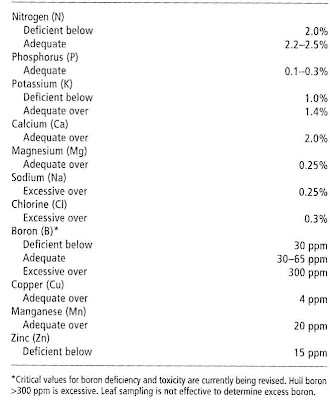Mid-July Leaf Sampling for Almonds
Leaf analysis of almond is a useful tool in diagnosing deficiencies, toxicities, and future nutrient needs of the tree. It provides an up to date analysis of the mineral composition of the tree, with desirable concentration of different elements known through extensive University of California research.Reasoning for sampling.As almond trees increase in size, their demand for nutrients also increases. Tree nutrient concentration is dependent upon the growth rate of the crop and the amount of nutrients that have been supplied naturally or through fertilizer. Under certain conditions, plant tissue may become deficient which could limit further growth and crop quality. Depending upon the nutrient and level of deficiency, remediation is possible in the current season, dormant period, or early spring of the following year. Leaf concentrations of major elements (nitrogen, phosphorous, and potassium) can be used along with kernel yield per acre to determine the nutrient budget for the next season.Process of sampling.Sampling should be distributed in a regular pattern across the block, with fully expanded leaves pulled from non-fruiting spurs on branches at least 6 feet high. About 100 leaves are needed for each sample. Leaves should be picked from trees of the same variety, age, rootstock, and soil type. Trees samples should be at least 100 feet apart and 20 trees are needed to ensure accuracy and confidence with the results. Partitioning of larger sampling blocks is advised to determine tree size and yield variability. Label the samples so the sampling location is known, and keep cool until they are sent to an analytical lab.Interpreting the results.Leaf analysis results are recorded either in percentages (%) or parts per million (PPM) of each element in a given weight of dried leaves. The table below contains the critical values for almond leaves sampled in July using the methods described previously. The critical values for magnesium, manganese, phosphorus, potassium, nitrogen, chlorine, and sodium are correlated highly with the appearances of deficiencies/toxicities. In other words,if symptoms of magnesium deficiency are diagnosed, a leaf sample will provide confirmation.Table 1: Critical nutrient levels (dry-weight basis) in almond leaves sampled in July.(Source: UC Almond Production Manual, Publication 3364, 1996) The importance of sampling in July.Many growers have been submitting samples to laboratories earlier in the season in order to prevent mid-season deficiencies. Sampling in spring time, during periods of active growth can be misleading due to the variability of true nutrient usage. Research has shown that the tree during this period is transferring large amounts of nutrients from source to sink, and may be devoting more nutrients to new growth instead of developed foliage, thus providing inaccurate data. Therefore the July sampling period was chosen for tissue analysis due to the relatively steady state of element levels within the leaf tissue. Furthermore, the critical levels established through experimentation and field observations by the University of California were made for sampling during July.In saying this, it is important to note that leaf samples that are taken for diagnostic work can be taken at anytime, as long as there are leaf samples taken from a healthy tree for comparison.Information used in this article has been abstracted from:Brown, P.H., and K. Uriu. 1996. "Chapter 26: Nutrition Deficiencies and Toxicities" Diagnosing and Correcting Imbalances. "University of California Almond Production Manual." University of California Division of Agricultural and Natural Resources. Publication 3364, Oakland, CA.
The importance of sampling in July.Many growers have been submitting samples to laboratories earlier in the season in order to prevent mid-season deficiencies. Sampling in spring time, during periods of active growth can be misleading due to the variability of true nutrient usage. Research has shown that the tree during this period is transferring large amounts of nutrients from source to sink, and may be devoting more nutrients to new growth instead of developed foliage, thus providing inaccurate data. Therefore the July sampling period was chosen for tissue analysis due to the relatively steady state of element levels within the leaf tissue. Furthermore, the critical levels established through experimentation and field observations by the University of California were made for sampling during July.In saying this, it is important to note that leaf samples that are taken for diagnostic work can be taken at anytime, as long as there are leaf samples taken from a healthy tree for comparison.Information used in this article has been abstracted from:Brown, P.H., and K. Uriu. 1996. "Chapter 26: Nutrition Deficiencies and Toxicities" Diagnosing and Correcting Imbalances. "University of California Almond Production Manual." University of California Division of Agricultural and Natural Resources. Publication 3364, Oakland, CA.
